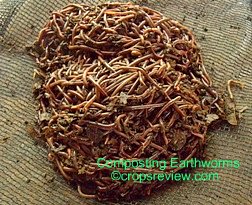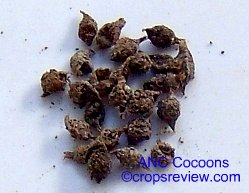The African night crawler (ANC), known scientifically as Eudrilus eugeniae, is considered as the most efficient epigeic or composting earthworm in the tropics (Guerrerro 2009).
Even in 1981, Graff (cited by Guerrero et al. 1999) already reported that the ANC was used for vermicomposting in the tropics.

The ANC was introduced into the Philippines by Dr. Rafael D. Guerrero III in 1982 via West Germany, the original cocoons courtesy of Dr. Otto Graff (Guerrero et al. 1984).
The origin of this species is West Africa, but it is now widely distributed in both tropical and subtropical countries of the world (Graff 1981, cited by Guerrero et al. 1984).
However, the African night crawler is only one of the most common species of earthworm that have been identified worldwide as having the best potential for breaking down organic materials.
These earthworms include the Eisenia fetida (tiger worm) and the closely related E. andrei, Dendrobaena veneta, and Lumbricus rubellus (red wriggler), all from temperate regions, and the Perionyx excavatus, and Perionyx hawayana from the tropics (Edwards and Arancon 2006).
According to Kale (2006), E. fetida is the universally accepted species for vermiculture.
The table that follows shows some of the comparative characteristics of selected composting earthworms.
Common Composting Earthworms
Reproductive Rates and Optimal Breeding Conditions for Common Composting Earthworms (from Edwards and Arancon 2006):
Table ANC-1. Reproductive rates and temperature requirements of african night crawler and two other species of composting earthworms.
| Properties | E. eugeniae | E. fetida | P. excavatus |
| No. of cocoons/wk | 11 | 6 | 24 |
| young worms/wk | 20 | 19 | 13 |
| Temp. range (C) | 9-35 | 0-35 | 9-35 |
| Opt. temp. (C) | 25 | 25 | 25 |
In addition, the African night crawler, P. excavatus, and D. veneta are:
- aerobic organisms just like other earthworms;
- have moisture requirement of 70-90% with optimum at 80-85%;
- are highly sensitive to ammonia such as occurs in fresh poultry litter;
- very sensitive to high inorganic salts with high conductivity;
- and have wide tolerance to varying pH ranges but prefers acidic conditions with optimum pH of 5.0.
According to Guerrero (2009), the young African night crawler matures in one month, grows to a length of about 30 cm, weighs 3 grams each, and continues to live for more than 1 month under favorable conditions.

Perionyx excavatus is also native to the Philippines.
James (2002) described the species in the following manner: “Clitellum covering 14-17, … worm with strong red-brown color and blue iridescence” and “Many setae per segment, spermathecal pores close together in 7/8, 8/9 intersegmental furrows, male pores on segment 18 in small pits in which there may be several setae visible, the pits are close together like the spermathecal pores, dorsal side deeply colored red-brown with a bluish iridescence, worms thrash when disturbed, length 4-8 cm, Family Megascolecidae, origin South Asia.” The culture of P. excavatus on animal wastes has been shown feasible (Kale et al. 1982, cited by Kale 2006).
LITERATURE CITED
EDWARDS CA, ARANCON NQ. 2006. The science of vermiculture: the use of earthworms in organic waste manangement. In: Guerrero R.D. III, Guerrero-del Castillo MRA (eds.). Vermi Technologies for Developing Countries. Proceedings of the International Symposium-Workshop on Vermi Technologies for Developing Countries. Nov. 16-18, 2005, Los Baños, Laguna, Philippines. Philippine Fisheries Association, Inc. p. 1-30.
GUERRERO RD III. 2009. Vermicompost and Vermimeal Production. MARID Agribusiness Technology Guide. 22 p.
GUERRERO RD III, GUERRERO LA, CARGADO AU. 1984. Studies on the culture of the earthworm Eudrilus euginiae, and its use as feed for Macobrachium idella and fertilizer source for Brassica compensis. Trans. Nat. Acad. Science & Technol. 6:33-40.
GUERRERO RD III, VILLEGAS LG, GUERRERO LA. 1999. Studies on the production and utilization of vermicompost produced with the African night crawler (Eudrilus euginiae) in the Philippines. Philippine Technology Journal. 24(1):57-62.
JAMES SW. 2002. An introduction to the study of Philippine earthworms. In: Philippine Council for Aquatic and Marine Research and Development. 2007. Readings and References on Vermicompost/Vermimeal Production and Utilization (compilation).
KALE RD. 2006. The role of earthworms and research on vermiculture in India. In: Guerrero R.D. III, Guerrero-del Castillo MRA (eds.). Vermi Technologies for Developing Countries. Proceedings of the International Symposium-Workshop on Vermi Technologies for Developing Countries. Nov. 16-18, 2005, Los Baños, Laguna, Philippines. Philippine Fisheries Association, Inc. p. 66-88.
